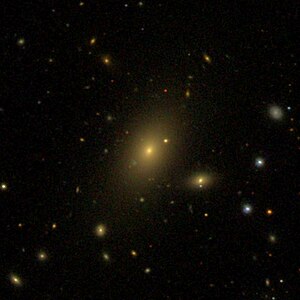NGC 3298
| Galaxy NGC 3298 |
|
|---|---|

|
|
| SDSS recording | |
| AladinLite | |
| Constellation | Big Bear |
|
Position equinox : J2000.0 , epoch : J2000.0 |
|
| Right ascension | 10 h 37 m 12.3 s |
| declination | + 50 ° 07 ′ 14 ″ |
| Appearance | |
| Morphological type | E-S0 |
| Brightness (visual) | 14.0 mag |
| Brightness (B-band) | 15.0 mag |
| Angular expansion | 0.9 ′ × 0.6 ′ |
| Position angle | 138 ° |
| Surface brightness | 13.4 mag / arcmin² |
| Physical data | |
| Redshift | 0.045068 +/- 0.000127 |
| Radial velocity | 13,511 +/- 38 km / s |
|
Stroke distance v rad / H 0 |
(606 ± 42) · 10 6 Lj (185.7 ± 13.0) Mpc |
| history | |
| discovery | William Herschel |
| Discovery date | April 12, 1789 |
| Catalog names | |
| NGC 3298 • PGC 31529 • CGCG 240-065 • MCG + 08-19-043 • 2MASX J10371222 + 5007143 • GC 2146 • H III 767 • h 725 • NVSS J103712 + 500712 | |
NGC 3298 is an elliptical galaxy of Hubble type E / S0 in the constellation Ursa Major at the northern sky . It is estimated to be 606 million light years from the Milky Way and about 160,000 light years in diameter.
The object was discovered by Wilhelm Herschel on April 12, 1789 .
